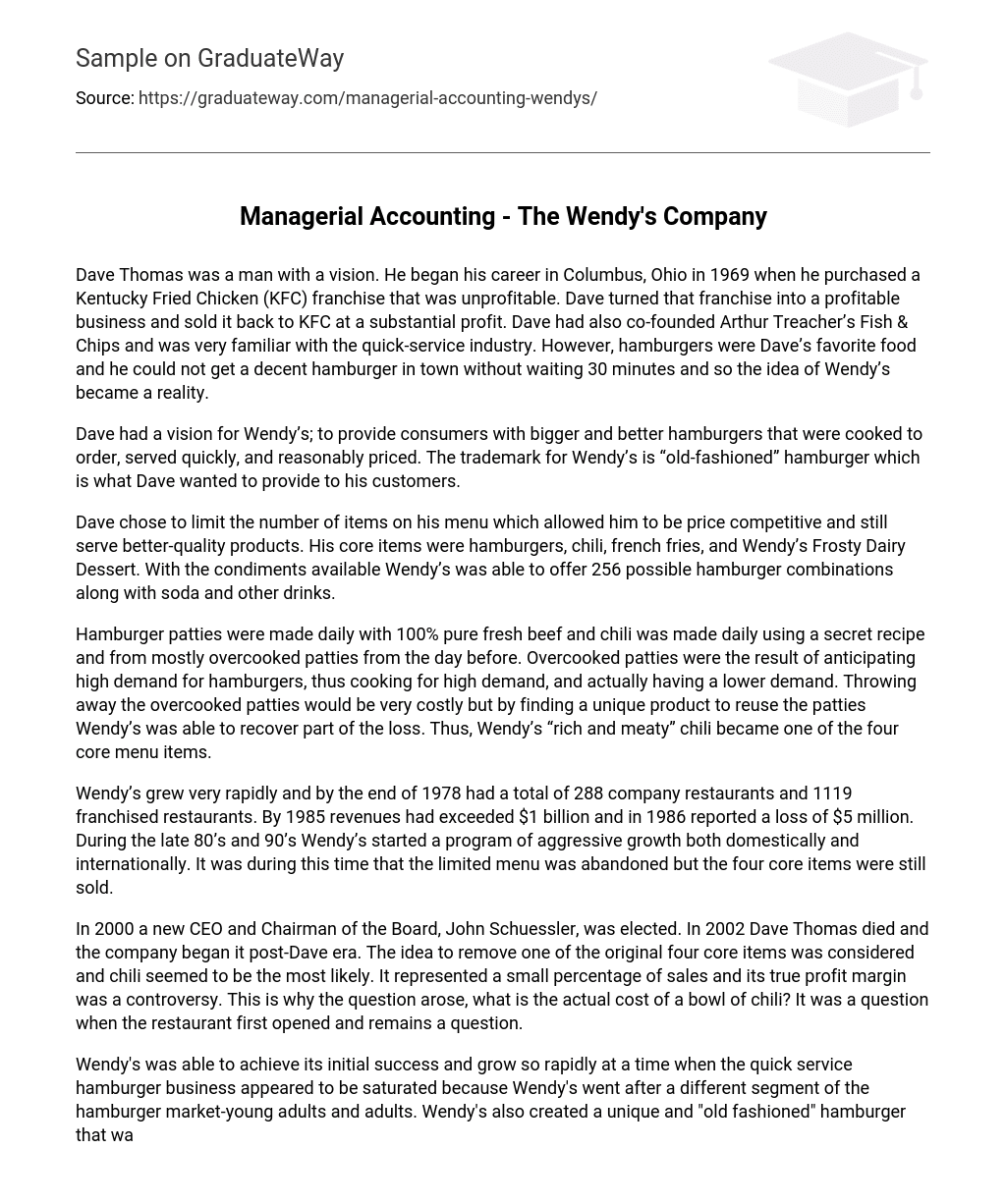Dave Thomas, a man with a vision, embarked on his career in Columbus, Ohio in 1969 when he acquired an unprofitable Kentucky Fried Chicken (KFC) franchise. Skillfully transforming it into a profitable business, Dave later sold it back to KFC, reaping substantial profit. Additionally, Dave was a co-founder of Arthur Treacher’s Fish & Chips and possessed extensive knowledge of the quick-service industry. However, despite his experience, Dave’s passion for hamburgers led him to notice the absence of a decent burger establishment in town that didn’t involve a 30-minute wait. This realization gave birth to the idea of Wendy’s, which eventually became a reality.
Dave envisioned Wendy’s as a place where customers could enjoy bigger and tastier hamburgers, cooked to their specifications, and served promptly at a fair price. He aimed to create an “old-fashioned” hamburger experience, which became Wendy’s signature trademark.
Dave decided to reduce the variety of items on his menu, enabling him to maintain competitive prices while offering higher-quality products. The main options included hamburgers, chili, french fries, and Wendy’s Frosty Dairy Dessert. With the range of condiments available, Wendy’s was able to provide customers with 256 potential hamburger combinations, as well as various soda and other drink choices.
Hamburger patties were prepared each day using 100% pure fresh beef, while chili was also made daily using a secret recipe and primarily from overcooked patties leftover from the previous day. The overcooked patties were a consequence of anticipating a higher demand for hamburgers and cooking accordingly, only to experience lower demand instead. Discarding the overcooked patties would have incurred significant costs, but Wendy’s managed to mitigate some of the losses by repurposing them into a unique product. Consequently, Wendy’s “rich and meaty” chili became one of the four main offerings on the menu.
Wendy’s witnessed a swift expansion, having 288 company restaurants and 1119 franchised restaurants by the end of 1978. Their revenues exceeded $1 billion by 1985; however, in 1986 they incurred a loss of $5 million. During the late 80s and 90s, Wendy’s pursued an ambitious expansion program both domestically and internationally while also abandoning the limited menu concept. Nonetheless, they continued to sell their four core items.
In 2000, John Schuessler was elected as the new CEO and Chairman of the Board. In 2002, after the passing of Dave Thomas, the company entered a new era without him. During this time, there was a suggestion to eliminate one of the original core items, with chili being the most probable choice. Chili accounted for a small portion of sales and there were debates about its actual profit margin. Hence, the question arose: what is the true cost of a bowl of chili? This question was present since the restaurant’s inception and continues to be unanswered.
Despite the apparent saturation of the quick-service hamburger industry, Wendy’s managed to attain its initial success and grow rapidly. This was primarily due to Wendy’s deliberate targeting of a different demographic—specifically young adults and adults. Additionally, Wendy’s introduced an unconventional square hamburger that surpassed the boundaries of the bun. These hamburgers were crafted using fresh 100% beef, cooked upon order, and served straight from the grill to the customer. This unique approach provided customers with transparency, allowing them to witness the quality of their food and enhancing their overall satisfaction. To distinguish themselves further from competitors in the quick-service sector, Wendy’s also offered their distinctive Frosty Dairy Dessert and chili.
Success at Wendy’s drive-through windows was the result of various factors. I personally believe that the consistency in building design, the advertising strategy, and the location, typically situated in urban or densely populated suburban areas, all contributed to this success. Additionally, I think that the limited menu options played a role in expediting order processing.
Based on my calculations, the full-cost basis estimates that making an eight-ounce bowl of chili amounts to $1.06. Meanwhile, the out-of-pocket cost for each serving is $1.10. If we solely consider the direct cost, then the chili costs $1.06 per bowl. However, excluding the chili is recommended based on this specific direct cost analysis.
However, the profitability of Wendy’s may be affected by numerous undisclosed factors. For instance, during the winter when chili sales are high, customers may visit to buy a hot bowl of chili and a hamburger. Eliminating chili, which is a staple at Wendy’s, might result in the loss of customers who purchase both chili and other items. Additionally, the cost of ingredients should be considered. Is it possible to obtain ingredients of equal quality at a lower price?





